Discovering Advancements in Virtual Reality Tech
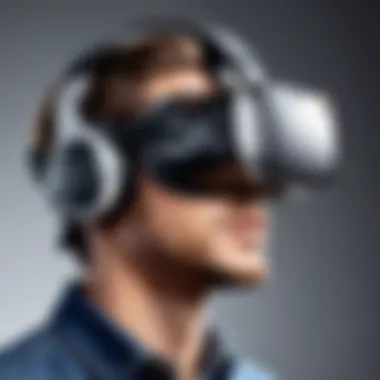
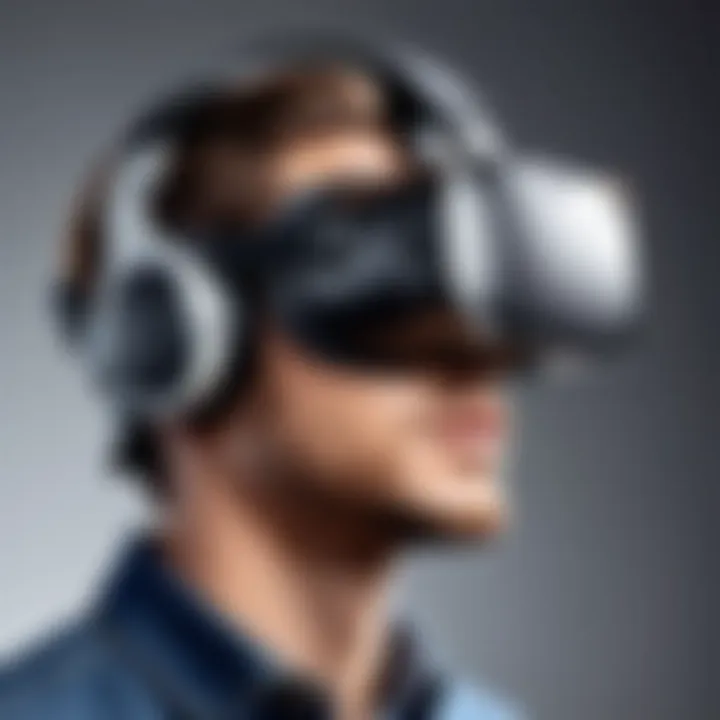
Intro
Virtual reality technology has come a long way since its early days, where it was mostly a figment of sci-fi imagination. Today, it stands at the forefront of technological innovation, tantalizing both consumers and professionals alike with endless possibilities. The advancement of VR brings with it not only immersive experiences for gamers but also practical applications in industries like healthcare, education, and real estate.
This guide aims to dissect the multifaceted world of virtual reality, providing a robust overview of the products leading the charge, along with their features and performance metrics. You might find the landscape both exciting and daunting, as the options are many and the technology behind them is often complex.
Understanding the nuts and bolts of VR is key, whether you’re a tech enthusiast wishing to sharpen your edges in gaming, an IT professional looking to integrate new solutions, or a casual user wanting to explore all that VR has to offer.
By examining aspects like product specifications, performance comparisons, and the pros and cons of leading technologies, this article is here to illuminate the choices available for anyone diving into the world of VR. Let’s embark on this journey into virtual realms!
The Evolution of Virtual Reality Technology
The journey of virtual reality (VR) technology is like a winding road, one that reveals the incredible advancements and innovations over the decades. Understanding how this technology has morphed over time is essential for grasping its potential and relevance in today's world. It isn't just about the flashy headsets and immersive experiences; it's about how VR has impacted various industries and the society at large. The evolution reflects findings from neuroscience, engineering, and design, all woven together to shape a medium that’s redefining human interaction with the digital space.
Historical Overview
Virtual reality isn’t just a product of the modern age; it’s roots stretch back to the mid-20th century. The first stirrings of virtual reality technology can be traced to 1962 with the creation of the Sensorama, a multi-sensory machine that allowed users to experience short clips in a more immersive format. Fast forward to the 1980s, when Jaron Lanier, a pioneer in VR, introduced the term "virtual reality" itself, prompting further exploration into this uncharted territory. It’s fascinating to think about how these early innovations laid the groundwork for what we experience today.
This historical context is crucial. For example, understanding the experimentation of the 90s, where VR was more fantasy than reality for most of us, helps one appreciate present-day usability. Companies like Sega and Nintendo made notable attempts, but they were wide of the mark. Physical limitations and technology constraints led to a tepid reception. Today, the landscape looks different, with high-fidelity graphics and deeper engagement with the virtual environment.
Milestones in VR Development
A series of milestones has punctuated the road to modern virtual reality technology, showcasing advancements that have turned dreams into reality.
- 1991: The Virtuality Group introduced arcade-style VR gaming, offering a glimpse into immersive entertainment.
- 2007: A huge shift occurred when the user-friendly iPhone was launched, providing the foundational technology for mobile VR. This was the catalyst for the rise of smartphone-compatible VR headsets.
- 2012: Oculus Rift kicked off the VR renaissance through successful Kickstarter funding, setting the stage for full 3D experiences and invigorating interest across the board.
- 2016: Sony PlayStation VR expanded accessibility, bringing VR into homes through consoles, allowing a wider audience to engage with virtual experiences.
Each of these milestones contributed to shaping the current state of virtual reality. This evolution didn’t merely come about through technology. It reflects a changing culture; consumers began craving deeper interactions with digital content. As technical barriers were lowered, VR transformed from an elusive dream to an accessible reality for tech enthusiasts, gamers, and healthcare professionals alike.
"To understand where virtual reality is heading, one must first look back at how far it has come. Each invention builds upon the last, creating a foundation of increasingly vibrant experiences."
Key Components of VR Systems
In the ever-evolving landscape of virtual reality, understanding the key components of VR systems is essential. These components are the building blocks that make immersive experiences possible, bridging the gap between the digital and real worlds. Each piece plays a pivotal role in creating an engaging environment for users. By grasping the significance of hardware essentials and software architecture, one can appreciate the full potential of VR technology.
Hardware Essentials
Hardware forms the backbone of virtual reality experiences. It encompasses several elements that are crucial for delivering realism and interactivity. Let's delve into the primary hardware pieces: headsets, controllers, and tracking sensors.
Headsets
Headsets are arguably the crown jewels of virtual reality technology. They serve as the gateway for users to step into immersive worlds. A standout characteristic of these devices is their ability to offer wide fields of view and high-resolution displays, which can significantly enhance the sense of presence in virtual environments.
One popular choice, the Oculus Quest, allows users to navigate expansive VR landscapes without cumbersome wires, providing a truly untethered experience. Its unique feature of hand-tracking boosts user engagement, enabling natural interactions without needing additional controllers. However, this convenience warrants careful consideration; while some users appreciate the simplicity, others may find the limited processing power of standalone devices to be a drawback compared to high-end PC-tethered options.
Controllers
Controllers are the tools that allow users to interact with virtual environments. The most vital aspect of these controllers is their ergonomic design, which enhances comfort during prolonged use. Devices like the Valve Index controllers stand out for their precision. They allow a fuller range of movement and grip, significantly lifting the user experience.
The unique feature of these controllers is their finger-tracking capability, which brings a layer of authenticity to interactions. However, they might come with a steeper learning curve and require users to adapt to their specific functionality, which some might find challenging.
Tracking Sensors
Tracking sensors are essential for capturing user movements accurately. Their significance lies in their ability to translate physical actions into digital representations. SteamVR base stations, for instance, offer unmatched precision in tracking. This hardware enables a user’s real-world movements to be mirrored in VR spaces without lag, propelling immersion to new heights.
A key characteristic of tracking sensors is their scalability. Users can increase the number of sensors to enhance tracking accuracy depending on their room size and use-case. However, a downside can arise in setups requiring extensive cable management and calibration, which may frustrate those seeking straightforward installations.
Software Architecture
While hardware is vital, software architecture functions as the stage on which these hardware components come to life. It encompasses the platforms and tools that enable the creation and distribution of VR experiences. Proper understanding of these elements is crucial for both users and developers alike.
VR Platforms
VR platforms act as ecosystems where users access various experiences. A notable example is the Steam VR platform, which offers an extensive library of games and applications designed specifically for VR.
One major characteristic is their multi-gaming support. This allows users to choose from a broad range of experiences, from gaming to educational content. The integration of social features lets users connect, adding yet another dimension to their experience. However, a potential downside is the fragmentation across platforms, sometimes leaving users with exclusive content locked away on different systems.
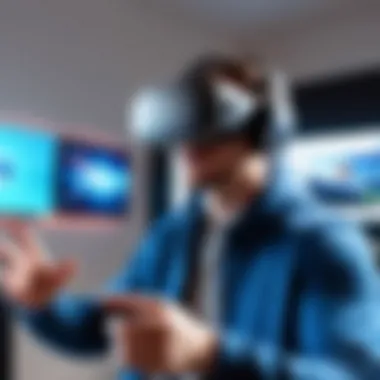
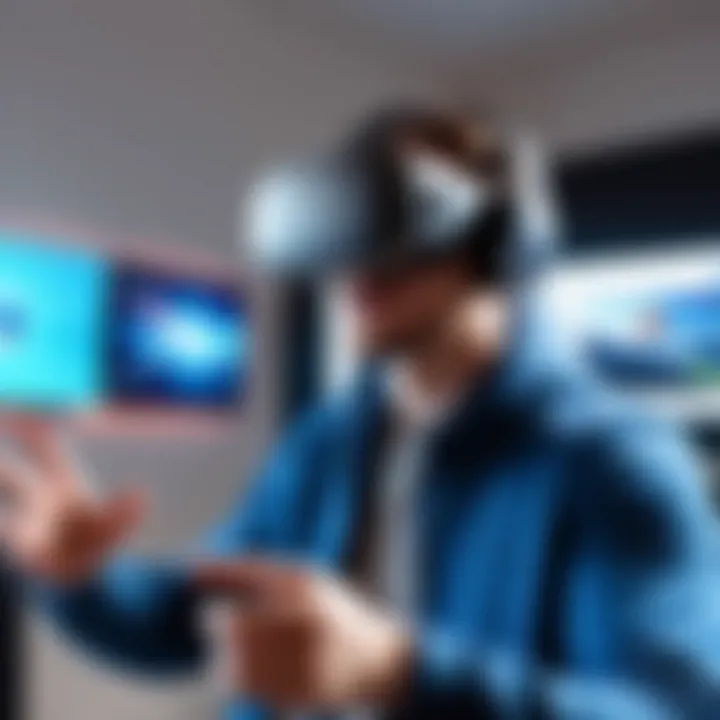
Development Tools
Development tools are critical for content creators who bring virtual reality experiences to life. Tools like Unity and Unreal Engine empower developers by offering robust environments for designing intricate VR worlds.
A highlighted feature of these tools is their vast resource libraries and community support, which foster innovation in development. Yet, the depth of these platforms can be overwhelming for newcomers, necessitating a steep learning curve before one can create polished content.
Understanding the key components of VR systems is fundamental for appreciating the technology’s capabilities and limitations. Each element plays a distinct role in crafting an immersive experience, shaping the future of how we interact with digital realities.
User Experience in Virtual Reality
User experience, often abbreviated as UX, plays a pivotal role in shaping how individuals engage with virtual reality technology. A seamless and immersive user experience can make the difference between a fleeting encounter and an experience that captivates. It's not just about making something that looks fancy; it's about understanding how users interact with the technology and designing it to meet their needs and expectations.
When users step into a VR environment, they should feel as though they truly belong there. This requires thoughtful exploration of two key elements: design considerations and user interaction methods. Let's delve into each aspect more closely.
Design Considerations
Interface Design
Interface design in virtual reality is not merely about aesthetics. It's about creating an environment that feels intuitive to navigate. One of the standout characteristics of effective interface design is its focus on user cognition. By utilizing familiar objects and gestures as interactive elements, developers can help users connect with the virtual space without a steep learning curve.
A beneficial choice in this realm is the adoption of spatial UI elements. These are interfaces embedded within the virtual space that mimic real-world interactions. For example, a virtual dashboard that appears above a user's hand can enhance engagement by providing instant access to essential information.
However, it’s also crucial to consider the potential disadvantages. Overloading the interface with information can lead to frustration and disengagement. A delicate balance is needed to keep it informative yet unobtrusive.
Accessibility Features
The importance of accessibility in virtual reality cannot be overstated. It ensures that users of all abilities can effectively engage with the technology. A primary characteristic of strong accessibility features is their capacity to enhance usability. For instance, incorporating voice commands allows users with limited mobility to navigate and interact without needing traditional controllers.
One unique feature that stands out is adjustable visuals. Users may have diverse needs regarding brightness and contrast settings. Allowing these adjustments can significantly increase usability and satisfaction. However, while such options are helpful, they rely heavily on the users having awareness of these features and understanding how to access them. This can present a barrier for those who may not be as tech-savvy.
User Interaction
Gesture Control
Gesture control signifies a leap toward a more natural interaction method in virtual reality. This system uses the user's body movements as input. A key characteristic of gesture control is its user-friendliness, allowing individuals to navigate their environments in ways that feel organic.
An interesting advantage of this technology is the elimination of traditional controllers, which can sometimes hinder immersion. Instead, users can reach out, grab, or push virtual objects as if they were physically present. Yet, implementing gesture control can come with challenges, such as the necessity for precise tracking. If the system misinterprets a gesture, this can lead to frustration and confusion during the experience.
Haptic Feedback
Haptic feedback is another vital component of user interaction in VR. This technology provides tactile sensations to enhance immersion, enabling users to 'feel' their actions within a virtual environment. A compelling feature of haptic feedback is its ability to simulate touch, adding a layer of realism absent from most traditional media.
This approach can greatly enrich gameplay or educational scenarios by enabling users to associate actions with real-world sensations. However, deploying haptic feedback can also present limitations, like the increased complexity and cost of integrating sophisticated feedback systems into VR headsets. Users might enjoy the immersion but could be deterred by the price tag or setup involved.
"User experience is the linchpin in virtual reality; without it, the technology is just a fancy gadget that no one knows how to use effectively."
In summary, understanding and implementing user experience strategies is essential in VR technology. It arms developers with insights needed to create intuitive, engaging, and accessible experiences. The careful consideration of design elements and interaction methods can lead to a landscape where everyone, regardless of ability or background, can dive deeply into the virtual worlds created for them.
Current Applications of VR Technology
Virtual reality technology has grown far beyond simple novelty; its applications span various fields, transforming industries and changing how we engage with content, learn, and even heal. By examining the current implementations of VR, we can appreciate its significance and unrealized potential. Understanding how each application operates highlights the benefits they offer and the considerations necessary for their advancement.
Gaming and Entertainment
In the realm of gaming, virtual reality is a game-changer—quite literally. Players no longer sit on a couch; they step inside the game. Immersion is taken to the next level. With headsets like the Oculus Quest series or PlayStation VR, users experience a first-person view that makes the virtual worlds come alive.
- Immersion and Engagement: Gamers can lose themselves in vivid landscapes or action-packed scenarios. The sheer thrill of scaling mountains in a fantasy world or surviving a zombie apocalypse feels real, drawing players deeper into the narrative.
- Social Interaction: Platforms like VRChat have emerged, allowing users to meet and interact with others in a virtual space, adding a social dimension to gaming that traditional platforms rarely offer.
However, the excitement isn’t without its challenges. For instance, not all VR games are created equal; some suffer from motion sickness issues, while others demand powerful hardware that might not be accessible to everyone. Ensuring a broader audience can enjoy these innovations remains a vital conversation in the gaming community.
Education and Training
Virtual reality in education offers innovative approaches to learning. Imagine students wandering through ancient Roman cities or conducting scientific experiments in a lab without the risks. Here’s how VR reshapes education:
- Experiential Learning: VR allows learners to engage with material in ways textbooks simply can’t match. Virtual field trips give history lessons a new dimension, while medical students can practice surgeries in realistic simulations without the ethical implications.
- Accessibility: Not every student can visit important historical sites or high-tech labs, but VR can make always-on, accessible experiences a reality, bridging gaps in educational equity.
These programs often require significant investment and development, but the potential outcomes—boosted engagement, improved retention rates, and a safer, more effective training environment—make them worthwhile pursuits. Institutions are slowly recognizing these advantages, but sweeping integration of VR in curriculums is yet to be fully realized.
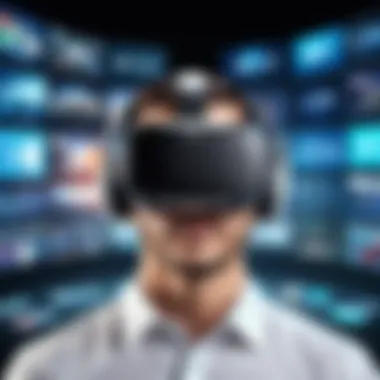

Healthcare Innovations
In healthcare, the stakes are high, and VR holds the promise of improving patient care and training for practitioners. Its applications here can be life-saving.
- Therapeutic Uses: For patients suffering from phobias or PTSD, VR therapy often helps in controlled environments where exposure therapy can take place. Gradually facing fears in a virtual setting reduces anxiety and builds coping strategies.
- Medical Training: Surgeons can practice procedures multiple times in a virtual environment before stepping into an operating room. This not only enhances their skill set but also minimizes mistakes in actual surgeries, positively impacting patient outcomes.
"As we progress, the opportunities for VR in healthcare to alleviate patient worries and enhance training promises a healthier future for many."
As VR technology continues evolving, the healthcare field will likely see even more applications, whether for preventative care or post-operative recovery initiatives.
In summary, the current applications of VR technology showcase its tremendous versatility. From gaming and education to healthcare, each sector experiences a tailored impact that opens doors to possibilities previously limited to imagination. Yet, challenges remain in scalability, accessibility, and technology integration. Addressing these issues will shape tomorrow's use of VR, ensuring it benefits a larger audience.
Leading VR Technologies and Devices
The realm of virtual reality is sprawling, evolving, and characterized by a few standout technologies and devices that lead the pack. Understanding these leading technologies is key for anyone looking to dive into virtual reality, whether for entertainment, education, or professional applications. Each device comes with its own set of features, considerations, and benefits that cater to different user needs and contexts. By highlighting these leading players, we can paint a clearer picture of what choices exist and what each brings to the table.
Oculus Quest Series
Overview
The Oculus Quest series, particularly the Quest 2, has carved out a significant space in the VR market primarily due to its all-in-one functionality. Users can jump right into the action without needing a tethered PC, which is a major advantage for those seeking ease of use and portability. The standout feature here is its inside-out tracking capability, which means users don’t need external sensors cluttering their space. This wireless freedom makes it a popular choice in homes where space is a premium.
Features
When it comes to features, the Quest series excels with its high-resolution display and a solid library of games and experiences. It boasts a refresh rate that can go up to 120 Hz, ensuring smooth visuals that keep users immersed. However, while the device is relatively affordable, some users might take issue with the limited battery life during extended play sessions. Still, the low entry price and accessibility of exclusive titles make it an appealing option for newcomers and seasoned gamers alike.
PlayStation VR
Compatibility
PlayStation VR stands out in the VR market due to its seamless integration with the PlayStation 4 and the forthcoming PlayStation 5. This device appeals to a broad audience, especially those who already own a PlayStation console. Its advantage lies in its compatibility with a plethora of popular titles that have been developed for console gaming. However, prospective users should note that dedicated headsets like the Quest series might offer a more immersive experience since PlayStation VR relies on external cameras and tends to require a bit of setup.
Exclusive Titles
What sets PlayStation VR apart are its exclusive titles. Games like Astro Bot Rescue Mission and Blood & Truth showcase the unique storytelling capabilities of VR, pulling players into captivating narratives that traditional gaming often lacks. While these games are a significant selling point, some may argue that the overall graphics experience lags behind standalone devices, primarily due to hardware limitations. Nonetheless, the availability of exclusive games makes it a compelling choice for PS gamers eager to explore VR.
Valve Index
Performance
The Valve Index is often revered by enthusiasts for its exceptional performance metrics. With one of the best refresh rates and an unparalleled field of view, it offers a silky-smooth experience that many argue makes it the best VR headset on the market currently. Coupled with high-quality audio and a responsive tracking system, it’s a device that doesn’t shy away from offering immersion. However, it does come with a steep price tag, making it a less accessible option for casual users who might not delve into VR frequently.
User Experience
User experience with the Valve Index is highly rated, thanks to its comfortable design and adjustable fit. The controllers are particularly praised for their finger-tracking technology, which leads to more natural interactions within virtual environments. Though some users may find the installation process demanding, those who prioritize experience over convenience will find it worthwhile. The immersive nature is further enhanced by the compatibility with a wide range of titles that are created for more serious VR users.
In the competitive landscape of virtual reality, understanding the various technologies and devices available is crucial for making informed choices that suit individual needs and applications.
Challenges Facing VR Technology
Understanding the challenges confronting virtual reality technology is crucial for anyone interested in its evolution and future. These obstacles not only shape the current landscape but also the potential for broader adoption across various fields. By addressing the fundamental issues—technical limitations and market penetration—stakeholders can better strategize on how to enhance and promote this rapidly developing technology.
Technical Limitations
Latency Issues
Latency, or the delay between user actions and system responses, poses a significant hurdle in VR experiences. High latency can lead to discomfort and motion sickness, detracting from the immersive experience that VR aims to create. The key characteristic of latency issues lies in its direct impact on the user's engagement and comfort levels.
In this discussion, the importance of low latency becomes evident. Low latency is essential for a smooth and responsive experience, allowing users to enjoy a more seamless interaction with the virtual environment. If latency is too high, users may feel as if their movements do not translate accurately to the VR experience. This disconnect can result in frustration and ultimately negate the entertainment value of the technology.
One unique feature is the implementation of predictive tracking, which aims to minimize latency by anticipating user movements. While this can significantly enhance user experience, it also raises concerns about accuracy. If the predictions are off, it could lead to an experience that feels less natural, prompting users to hesitate before fully immersing themselves. The challenge remains to refine this technology for maximum benefit while maintaining a genuine feel in the virtual space.
Display Quality
Display quality is the cornerstone of any immersive experience in VR. It affects how users perceive the virtual world and contributes directly to their overall satisfaction with the technology. The standout feature of display quality is its resolution. Higher resolution displays provide sharper images, which are essential for creating lifelike environments.
In this context, the discussion revolves around the impact of display quality on user immersion. Low-resolution displays can cause uncomfortable experiences, with users observing pixels instead of smooth imagery, which can take them out of the experience. This disruption is particularly problematic in applications requiring a high level of detail, such as architectural visualization or detailed medical simulations.
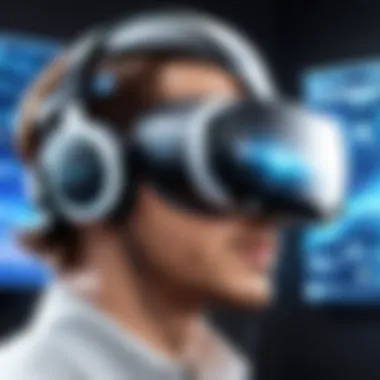
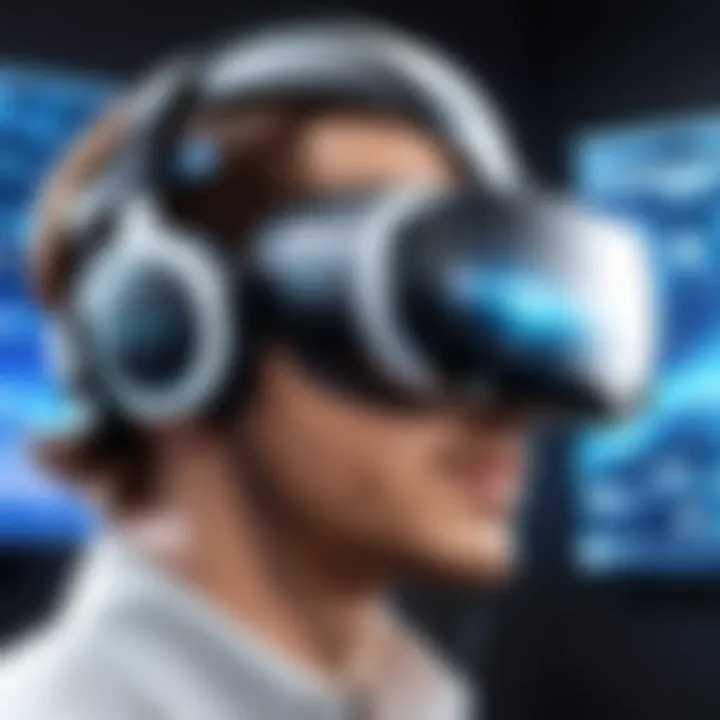
As resolution improves, users gain clearer visuals and greater depth perception. However, churning out higher quality displays often comes at a price, raising the cost of devices and potentially limiting accessibility to the average consumer. Thus, while top-notch display quality is a desirable trait, it can also lead to debates about pricing and market reach.
Market Penetration
The second significant challenge facing VR technology is its market penetration. Despite the advancements and increasing interest, the uptake in various industries is not as widespread as it could be.
Cost Barriers
Cost barriers remain a major roadblock in the expansion of VR technology. The initial investment needed for high-quality headsets, controllers, and supporting hardware can be steep. As a result, many potential users and businesses might shy away from exploring the advantages that VR can offer. In this narrative, we must highlight that affordability is a key consideration in determining whether VR enters wider consumer markets.
What is unique about cost barriers is how they straddle both user experience and overall viability of the technology. As long as prices remain high, the audience that can access and experiment with the technology will be limited. This situation creates a two-sided dilemma: manufacturers need to sell at higher prices to recoup costs, while potential consumers find those prices not justifiable without a clear return on investment.
Consumer Adoption
Consumer adoption speaks to how eager users are to embrace VR technology. This adoption curve can be slow, influenced by various factors, including perceived complexity and lack of awareness. In contrast, early adopters and tech enthusiasts demonstrate enthusiasm, yet the mass market adoption remains elusive.
A vital thread in this narrative is the need for education and the demonstration of clear value. Consumers often hesitate if they don’t fully understand how to integrate VR into their daily lives or businesses. Unique to consumer adoption is the trend of companies increasingly leaning towards experience-driven marketing strategies to promote their VR offerings. These strategies involve showcasing the actual benefits in practical scenarios, aiming to generate interest and inspire users to take that leap.
Ultimately, addressing these challenges will play a major role in the growth of virtual reality technology and its integration into society. Innovations cannot unfold in a vacuum; they need realistic pathways to reach a broader audience, merging technical advancement with user accessibility.
Future Trends in Virtual Reality
The realm of virtual reality (VR) is ever-evolving, transforming the way we interact with technology and experiences. Understanding future trends in this area is pivotal, not just for enthusiasts but for industries looking to harness its potentials. As we look ahead, certain elements stand out—advancements in technology and increased integration across various sectors.
Advancements in Technology
As technology progresses, the VR landscape is set to change in ways we can barely fathom today. New advancements promise to provide smoother experiences and more immersive environments.
- Enhanced Graphics and Processing Power: Devices will likely boast improvements in resolution and frame rates, pushing the boundaries of realism further. Brands are quietly developing graphics that can mimic reality so closely, enhancing immersion.
- AI Integration: The fusion of artificial intelligence with VR is an exciting prospect. This partnership could lead to smart environments that adapt to user actions, creating personalized experiences that feel remarkably intuitive. Imagine walking into a virtual space that feels tailored just for you.
- Wireless Freedom: The movement away from wired setups is accelerating. Future headsets are aiming for completely wireless designs, reducing clutter and enhancing user mobility. This shouldn't just help in comfort; it fosters a more natural interaction with the VR world.
These advancements collectively hint at a future where VR is seamlessly interwoven into our daily lives, enhancing not just entertainment but also learning, collaborating, and beyond.
Increased Integration Across Industries
Retail
Retail is on the frontier of tapping into VR's capabilities. The immersive nature of VR offers customers something significant: a unique shopping experience.
- Virtual Showrooms: Retailers are creating virtual storefronts that allow customers to walk through and physically interact with products, almost as if they’re in an actual store. This is particularly beneficial for items like furniture, where seeing products in a realistic setting can influence purchasing decisions.
- Personalized Shopping Experiences: By leveraging customer data, retailers can tailor virtual experiences. Imagine a store that remembers what you like and suggests products while you're immersed in a VR setting. This combines convenience with a personal touch that today's consumers often seek.
However, there are challenges. For one, not all consumers are comfortable with VR shopping experiences. Moreover, the cost to set up such technologies can be high, which could deter smaller businesses from jumping in this trend.
Real Estate
The real estate industry is embracing VR like never before, realizing its potential to reshape how properties are showcased.
- Virtual Tours: Prospective buyers can now explore properties from the comfort of their homes. Realtors can stage homes in VR, allowing clients to walk through virtually, ensuring they feel a connection before even visiting the property in person. This saves time for both buyers and sellers.
- Visualization of Future Developments: With the ability to visualize spaces before they exist, clients can better understand what a project will look like upon completion. This not only enhances buyer confidence but can also expedite the decision-making process.
On the downside, creating realistic VR models can require substantial time and resources. Moreover, clients might come across barriers if they do not have access to VR devices or lack familiarity with the technology.
"The future of virtual reality isn't just gaming; it's about transforming experiences across numerous sectors."
In this rapidly evolving landscape, the convergence of technological advancement with industry necessity will pave the way for VR to become a commonplace tool in not just entertainment but daily life itself.
Epilogue
The virtual reality landscape is constantly evolving, offering many opportunities to reshape how we experience digital environments. The examination of virtual reality technology showcased in this article underscores not only the profound impact it has on industries like gaming, education, and healthcare, but also the significance of user experience and technological innovation. With each advancement, VR is carving out more space in our everyday lives, providing immersive experiences that were once mere fantasies.
Summary of Key Insights
Delving into the world of VR reveals several crucial points:
- Technological Evolution: From its early days, virtual reality has undergone remarkable transformations that have refined both hardware and software, making it more accessible and effective for users across the board.
- Diverse Applications: The applications of VR are wide-ranging, touching everything from interactive entertainment to complex training simulations. This versatility is helping various sectors leverage VR for enhanced outcomes.
- User Experience Focus: A successful VR experience hinges on how well designers incorporate user feedback and address accessibility needs, ensuring that the technology serves a growing pool of users.
- Challenges Ahead: Even with its growth, there are hurdles to clear, like market adoption issues and technical limitations that affect the seamless consumer experience.
"VR is not just about being in a virtual world; it's about enhancing the real world through immersive experiences that educate and entertain.”
The Path Ahead for VR Technology
Looking towards the future, the trajectory for virtual reality is mirrored by its potential for integration in various fields. As technology advances, we expect notable trends that may redefine how users engage with virtual experiences:
- Improved Hardware: As manufacturers work on more lightweight and effective headsets and controllers, the overall experience is likely to become more intuitive.
- Enhanced Content Creation: The tools available for developers are becoming increasingly sophisticated, fostering creative expression and making it easier to bring innovative VR content to life.
- Industry Integration: Sectors such as retail and real estate are beginning to realize the benefits of VR in presenting products and properties in ways that traditional methods cannot match.
The landscape of virtual reality is not just an exciting frontier for gamers but a promising field ripe with potential for enhancing human experience across various industries. As we look ahead, the commitment to refining these experiences—the core of this technology—is paramount for its future success.







